12 Best Digital Products To Sell Online (+ How To Get Started)

Looking for the best digital products to sell online? You’re in the right place.
Digital products typically have much higher profit margins than physical products.
And because you don’t have any production costs to worry about, you can scale up infinitely without ever having to worry about replenishing your inventory—all of which makes for an easy and very lucrative business model.
If you want to start your own online business selling digital products, read on and you’ll learn everything you need to know.
In this post, you’ll find the most profitable digital products to sell, how to get started selling each one. And, stick around to the end to learn the best ways to market digital products.
What are digital products?
Digital products are intangible goods that can be stored electronically and sold online repeatedly.
They typically take the form of downloadable content and media files.
We’re talking about things like ebooks, PDFs, music and video files, templates, etc.
12 types of digital products to sell
There are many different types of digital products that can be sold online. To help you to narrow down your options, we’ve listed some of the most lucrative digital product categories below, alongside examples of successful sellers in that niche.
1. Ebooks (and audiobooks)
There’s a lot of money to be made selling ebooks. They’re one of the top information products that consumers like to spend their hard-earned cash on.
The market has grown substantially in the last few years, with the number of ebook units sold rising from 170 million to 191 million from 2019 to 2020 alone. And with sales still soaring, now’s the perfect time to write your own and claim your share of the pie.
But don’t worry, you don’t have to be Stephen King to write something that sells well. Just write about what you know—there are all kinds of ebook niches that are surprisingly lucrative, especially in the non-fiction / educational category.

For example, Dubai-based YouTuber Amel Aitouche wrote an ebook that outlines everything you need to know about moving to Dubai. It proved to be a big hit with her subscribers and she’s now selling hundreds of copies, making her one of the biggest success stories.
You could even turn your books into audiobooks to reach an even larger market of casual listeners. And if you don’t have time to write a whole ebook, you can sell shorter texts like how-to guides, meal prep plans, workout guides, blueprints, and other documents.
Note: If you need more help, check out our posts on how to sell ebooks, platforms to sell ebooks, and how to sell audiobooks.
2. Online courses
Another great way to monetize your knowledge is to create and sell an online course. Is there a topic that you’re a real expert in? Do you have any particular skills you think others could benefit from? If so, you can package those skills and expertise into a digital product and sell it.
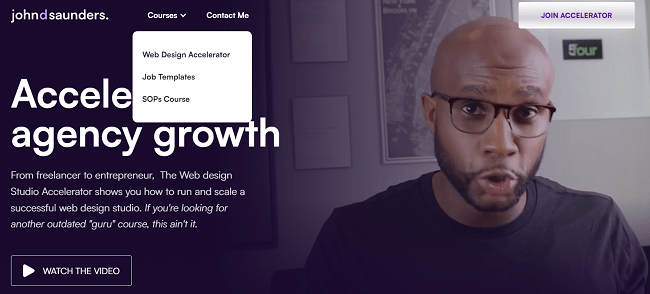
John D. Saunders did just that and made over $10,000 on launch day alone through his web design accelerator and SOPs courses. Now, he runs a six-figure business and has made hundreds of thousands of dollars selling courses online.
Of course, not everyone will have as much success as John, but that doesn’t mean you can’t make a good income if you have knowledge that’s in demand.
Here are some ideas for different kinds of online course niches that sell really well:
- Fitness courses
- Cooking courses
- Music courses
- Business and entrepreneurship courses
- Language learning courses
- Art courses
- Dating and relationships courses
Once you know what you want to teach, you’ll need to decide what kind of format you want to deliver your course in (i.e. video, text, audio, etc). After that, you can outline a curriculum and start creating your educational content.
When your content is ready, you’ll need to choose an online course platform to host your course. Then, use these tactcs to market your course.
3. Digital art
Fancy yourself an artist or graphic designer? There’s a big market out there for digital art, so monetize those skills and turn your hobby into a source of income.
For example, new startups are always in need of talented designers to create custom logos for their businesses.
While there are online logo makers that provide an affordable option for small businesses, they can’t match what a skilled graphic designer can create. This allows you to charge a premium for your work.
Other art-related digital products that sell well include stock icons (vector images), brand kits, backgrounds, emotes, badges, banners, and 3D artwork.
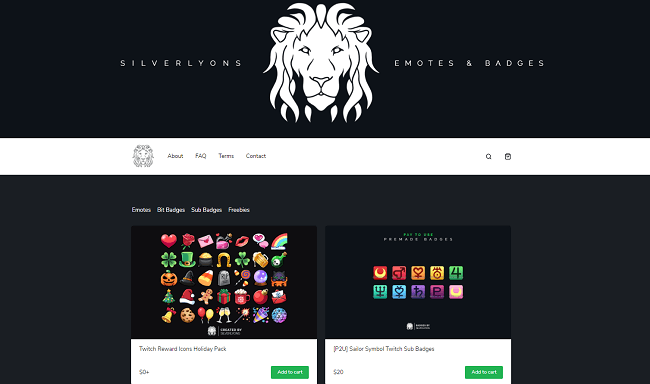
Designer SilverLyons capitalized on the growth of Twitch streaming and released a collection of premade emotes, icons, and badges. If you’re an avid gamer, you can do something similar and tap into the same market.
Aside from creating your own original designs, you could also sell add-ons for popular graphic design tools. Brushes, gradients, and palettes for software like Photoshop, Illustrator, and Procreate are in high demand right now, so it’s definitely a market worth exploring.
NFTs are a hot topic right now too, especially in the digital art space. If you’re already selling digital art, you could consider branching out into NFTs. However, this can be a risky venture, so make sure you do your research and understand the risks.
Note: Want to start selling your digital products but not sure how? Sellfy makes it easy. Click here to start your free trial.
4. Subscriptions and memberships
Starting a members-only site and selling subscription products is another great idea, especially if you’re already an influencer with a large audience.
For example, YouTubers Rhett & Link from the Good Mythical Morning channel opened up a new recurring venue stream when they started the Mythical Society — a private online community that gives subscribers access to behind-the-scenes footage and exclusive content. Because they already had millions of subscribers, sales were pretty much guaranteed.
But while having an existing audience certainly helps, it isn’t essential — you can still launch a successful subscription service without it, like creator Attune to the Moon, who has found success selling seasonal subscription packages in the spiritual wellness industry.

Your subscription packages could include weekly or monthly content, like magazines or meal plans, access to a gated social community, and various other goodies.
Check out our post on ecommerce platforms to sell subscriptions if you need help.
5. Video content
Consumers these days can’t get enough video content—and they’re willing to pay for it. You only have to look at the success of VOD streaming services like Netflix to see just how big the market for video content is.
If you fancy yourself a director, you can create your own entertaining or educational video content and sell it online.
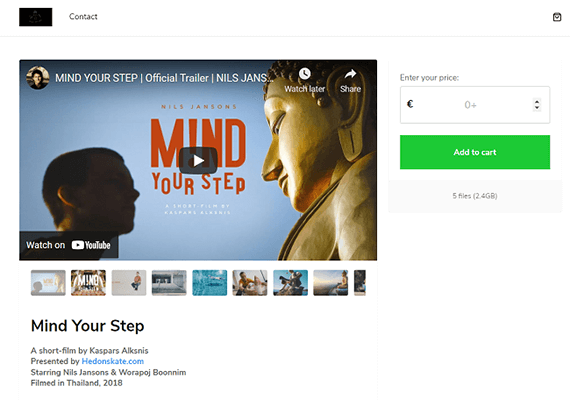
Creators Nils and Kaspar did just that. They went to Thailand and filed a short inline skating film called Mind Your Step, which documented their journey across the country and brought attention to the global plastic waste issue, then listed it for sale in their online store. It was a big success and the pair managed to raise a ton of money for charity.
And if you think making a movie sounds too costly, bear in mind that Nils and Kaspar managed it on less than 5,000 euros, proving that it doesn’t have to be. You can make something worth paying for on a shoestring budget using nothing more than an iPhone camera. You just need a vision.
Types of video content that can sell well include educational video content, exclusive vlogs, travel documentaries, comedy videos, short films, and gaming videos.
Note: If you need help getting started, check out our guide to selling video content.
6. Patterns and printables
There are millions of crafty consumers out there on sites like Etsy looking for patterns and printables to help them with their DIY projects.
You can sell things like sewing patterns, knitting patterns, and macrame patterns, or printables like coloring pages and workbooks.
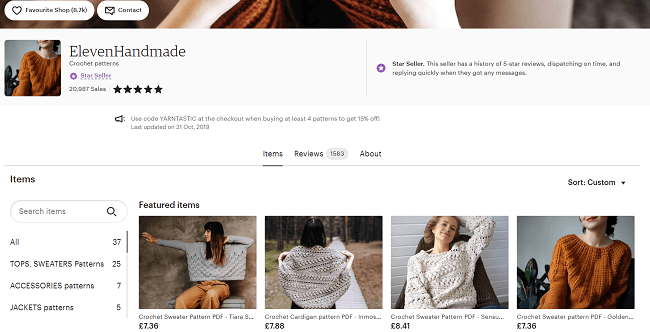
Latvian textile designer and entrepreneur Linda offers a great example of this. The self-taught hobbyist turned award-winning textile designer founded the ElevenHandmade brand and built herself a profitable business selling crochet patterns online — and they’re a huge hit! Her Etsy store has over 20k sales to date.
Check out our article on digital products to sell on Etsy if you’d like to get some extra inspiration.
7. Templates
Templates are another interesting category of digital products that sell well online. Resume templates are very popular and super easy to create, even if you have limited design skills.
But templates aren’t just for resumes and CVs. You can sell templates for all kinds of things, including emails, social media posts, PowerPoint presentations, Twitch overlays, business cards… you name it!
For example, brand My Social Boutique has released one of the best-selling templates on Creative Market.

Their bundle of 400+ engagement-boosting templates for Instagram has generated over 2,000 sales to date. Priced at $49 for a commercial license, that translates to almost $100k in revenue!
8. Photography
High-quality photos are always in demand. If you’re an avid photographer, you could turn your hobby into a full-time career by selling your photos online.
One way to go about this is to sell stock photos on sites like Shutterstock, but it’s a bit of a crowded market and can be tough to break through the noise and make sales. You may have more success selling client-commissioned photos, event photography services (think weddings, birthdays, etc), and portraits.
Whatever direction you want to go in, a good photography portfolio that showcases your best work is a must. This will help you to stand out from the crowd.
If you don’t want to sell photos, you could even sell merch inspired by photography, like talented photographer Megan Hein.

She turned her passionate hobby into a full-time business when she launched her own Sellfy store, through which she sells POD products and apparel for photographers.
9. Photo presets
If you’re a photographer, another direction you can take is to sell custom Lightroom presets.
Lightroom presets are essentially filters that add a certain tone and feel to your photos. Buyers can download them and install them on their Lightroom software, then apply them to their photos.
If you have a large audience of people that already like your work (such as a big Instagram following), there’s a good chance some of your fans will want to know your secret and be willing to pay for your presets in order to get the same effect.
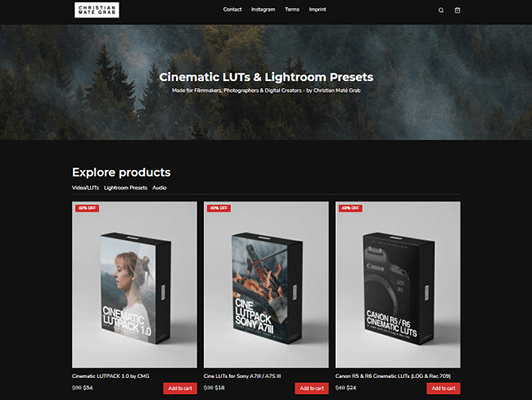
German-based photographer Christan Mate Grab capitalized on this and made his presets available for purchase in his online store, opening up a new and lucrative source of revenue.
10. Music
If you’re a talented musician, you might want to look into selling music and music-related products online.
The most straightforward example of this is to sell licenses. There are thousands of filmmakers, producers, and YouTubers out there that need original tracks and sound effects to use in their work. You can charge these businesses and individuals for a license that grants them copyright-free rights to use your tracks in their videos.
If you have a following, you could also sell downloadable song files or even whole albums through your online store on streaming services like Spotify.
Another route you could go down is to sell sheet music, music-related knowledge products like online guitar or drum lessons, or even sound banks.

For example, the LFO store sells soundbanks for the world’s leading synthesizers. Their product catalog includes hardware synths, software synths, effects, and sample packs.
Note: I published a detailed guide to selling music over on my music blog. Check it out if you need help getting started.
11. Fonts
Fonts are another one of the best digital products to sell online. Design trends and consumer preferences are constantly changing, so brands, designers, and individual creators are always looking for new fonts to use in their branding and artwork.
You can create your own fonts in software like Illustrator and then sell them as downloadable OTF or TTF files via your own website or through online marketplaces like Creative Market.
There are hundreds of fonts listed for sale on Creative Market, spanning all kinds of categories, from calligraphy-style fonts to cutting-edge 3D fonts. The most popular typefaces sell like hotcakes.

Most sellers opt for a licensing model, in which they charge separate fees for commercial licenses and personal licenses. You may want to make your fonts available for personal use for free as part of your marketing strategy and charge only for commercial use.
Note: Check out our beginner’s guide to selling fonts, if you want to learn more.
12. Software
And of course, no list of digital products would be complete without mentioning software.
Selling SaaS (software-as-a-service) products online can be one of the most lucrative business models, with companies like Ahrefs and Mailchimp earning millions in revenue.
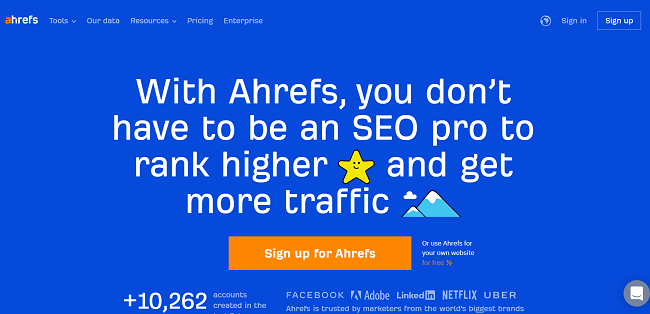
However, selling software isn’t as easy as selling some of the other digital products on this list. You’ll need to find a gap in the market and spend time and money developing a software solution that consumers need.
This typically requires you to hire a team of developers to work on your software product, which can cost hundreds of thousands of dollars.
But despite the expensive startup costs, if your software product takes off, you could see a big return on your investment and end up with a 7- or 8-figure business.
How to sell digital products
Once you’ve figured out which digital product you want to sell, the next step is to set up your online store. For this, you need an ecommerce platform.
There are plenty of ecommerce platforms geared towards selling digital products, but we’d recommend starting off with Sellfy.
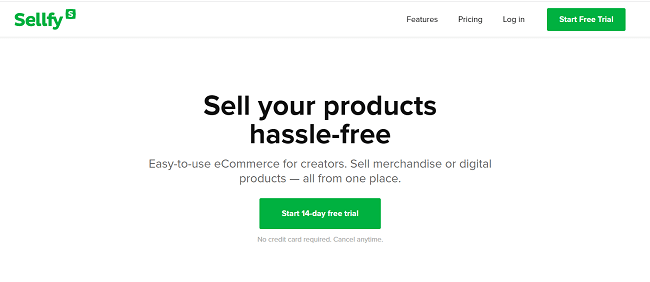
It’s one of the easiest (and most affordable) platforms to get started with, which makes it perfect for beginners, small businesses, and solopreneurs who want to sell digital products online.
Here’s a step-by-step guide on how to sell your digital products using Sellfy.
Step 1: Choose a subscription plan and create your Sellfy store
We recommend going with the Starter plan straight from the get-go. With the Starter plan, you can sell unlimited products for just $19/month and you get a 14-day free trial to test out all the features.
To get started visit the Sellfy website and sign up for an account. Choose the Starter plan.
Then fill in your details and click Create my store. You’ll then be prompted to fill out a questionnaire about the type of store you’re creating. If you’re starting your ecommerce store from scratch, be sure to select the Create a Sellfy storefront option on the 3rd question.
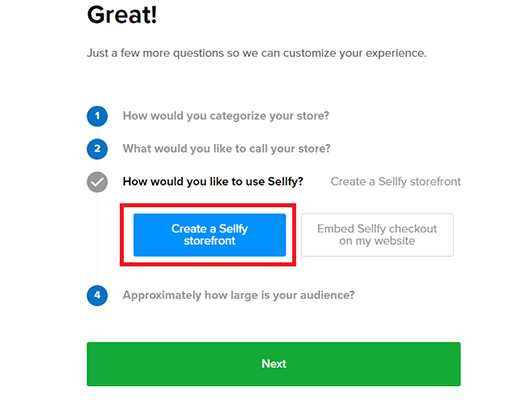
After you’ve completed the questionnaire click Start 14-day free trial and you’re ready to begin creating your store and adding your products.
Step 2: Add your digital products
Once your store is created, you can add any products you wish to sell by clicking Products > Digital products in the sidebar. Then click Add new product.
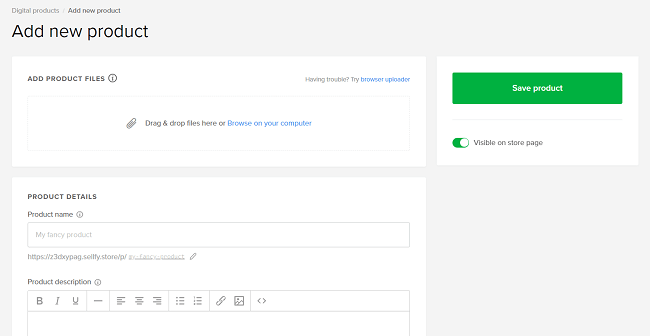
Then you can simply add the digital products by dragging and dropping them in the box provided or by clicking Browse on your computer.
On this page, you can also add important product information such as a product name, description, preview, and price. When you’re done, just click Save product and make sure that the Visible on store page toggle is on and your products will be ready to sell.
Step 3: Customize your store settings
Next, click on the Store settings tab in the sidebar. This is the tab you can use to change the look of your site and make important customizations such as adding a domain name and setting up payment options.
You can change how your site looks using the Store customizer. Here you can change the theme and rearrange the layout of your store pages.
Once you’re happy with the way your site looks you can set up payment options by connecting your store with Paypal or Stripe.
Also, you can add a custom domain name for your online store. If you’ve already purchased a domain, simply add it in the Custom Domain field on the Store settings page.
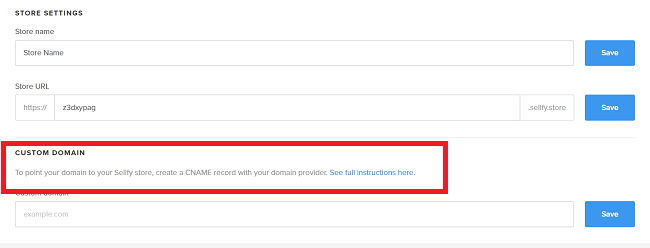
If you need to purchase one, you can do so on sites like GoDaddy and Namecheap. Here’s a list of some of the best domain name registrars to purchase from.
The Store settings area can also be used to set up other important aspects of your site such as your email settings and product categories.
Note: Sellfy will also allow you to sell physical products, print-on-demand merch, video streaming, and subscriptions. You can use it to sell courses as direct downloads, however, there is no learning management system included at the moment.
9 ways to market your digital products
It’s not enough to create great digital products and an awesome online store. Because if nobody ever sees your store or knows it exists, you’re still not going to make any sales.
That’s why marketing is so important. There are many different ways to market your digital products. Here’s an overview of what we think are the most effective strategies worth trying.
Invest in SEO (Search Engine Optimization)
SEO is all about optimizing your digital product website pages for search engines so that they show up in the results whenever potential buyers search for target keywords related to your niche. The great thing about SEO is that it drives organic traffic, rather than paid traffic, which means you don’t have to keep spending money on ads to see results.
Read our beginner’s guide to SEO to find out how to get started.
Launch a PPC ad campaign
PPC stands for pay-per-click. With PPC ads, you launch an advertising campaign (such as through Google Ads or Facebook Ads), bid on ad placements, and pay whenever somebody clicks on your ad through to your landing or sales pages. If you get your targeting options right and convert a good chunk of those ad clicks to sales, PPC ads can generate a high ROI (return on investment).
Maximize your conversions
SEO and PPC are great for driving traffic to your online store, but if you’re not converting enough of that traffic to sales, you’re not going to see a good ROI. That’s why CRO (conversion rate optimization) is so important. Make sure all your online storefront is a well-oiled conversion machine and that all your landing pages are laser-targeted to drive sales or get customers into your sales funnel.
Promote your products on social media
Social media is a powerful marketing channel. Find out which social networks your target market is most active on (e.g. Facebook, TikTok, Instagram, etc) and focus your efforts on building a presence and following on those networks. You might even want to consider partnering with social media influencers with a large following of people in your target market for influencer campaigns in order to maximize your reach.
These 13 smart social media marketing tips will help you get started. And these social media management software tools will save you time.
Launch a giveaway campaign
Running a contest or social media giveaway can be a powerful social media marketing strategy. The idea is to offer some kind of free reward (such as a free subscription or product giveaway) to the winner, and hand out entries in exchange for things like sharing your post or liking your business’ social page.
You’ll need a social media giveaway solution to get started. See our roundup of the 10 best contest tools here.
Offer a lead magnet
If you’re selling a digital product online, consider making a light or trial version of it for free and offer it as a lead magnet. Lead magnets are incentives (such as freebies) that you give away to your website visitors in exchange for their data. It can be a great way to encourage more people to opt-in to your newsletter and build your email list.
To learn how to create your own lead magnet, check out this post.
Leverage email marketing
Once you’ve grown your mailing list, you can leverage email marketing software to set up automated email campaigns that nurture your subscribers with information, offers, and discounts until they’re ready to buy. You can also implement things like automated abandoned cart emails to reduce cart abandonment and land more sales.
See our Email Marketing 101 guide to learn more.
List your products on online marketplaces
It makes sense to list your digital products on as many marketplaces as possible in order to reach more potential customers. In addition to your Sellfy store, you might want to list your digital products on sites like Etsy (great for patterns and printables), Amazon (ideal for ebooks and video content), and Envato Elements (great for fonts).
Selling digital products FAQ
Still keen to learn more about selling digital products? Here’s the answer to some frequently asked questions on the topic.
Is selling digital products profitable?
Yes, selling digital products can be extremely profitable, and you don’t have to worry about many of the overheads and costs associated with selling physical products.
Providing you choose the right products and market them well, selling digital products online can be a very lucrative business.
Can I sell digital products on Facebook?
Yes, it’s more than possible to sell digital products on Facebook Marketplace. However, it’s more common to use platforms such as Amazon and Etsy for selling digital products. Using social media and Facebook ads can be a great way to market your products too.
Can I sell digital products on Instagram?
Although Instagram has some shopping features, it’s not really set up for selling digital products. It’s more suited to selling physical products. However, Instagram can be a great way to promote your products and direct traffic to your ecommerce store.
Final thoughts
So, there you have it—everything you need to know about how to sell digital products online. Thanks to ecommerce tools like Sellfy, selling digital products online couldn’t be easier. It’s a very simple and effective way to make money online.
Hopefully, you found some great digital product ideas on this list.
If you still want to learn more about making money online, be sure to check out some of our other posts such as:
- 26 Best Products To Sell Online (According To Data)
- Side Hustle Ideas: 50 Legit Ways To Earn Extra Money
- 6 Ways To Get Paid For The Content You Create
- 7 Value Proposition Examples (And How To Create Your Own)
- How To Come Up With New Product Ideas: 20 Proven Methods
Disclosure: Our content is reader-supported. If you click on certain links we may make a commission.
